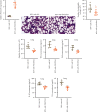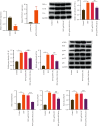POU Class 2 Associating Factor 1 Exerts a Protective Effect on the Respiratory Syncytial Virus-Induced Acute Bronchiolitis by the NF- κ B Pathway
- PMID: 37260522
- PMCID: PMC10229246
- DOI: 10.1155/2023/2815219
POU Class 2 Associating Factor 1 Exerts a Protective Effect on the Respiratory Syncytial Virus-Induced Acute Bronchiolitis by the NF- κ B Pathway
Retraction in
-
Retracted: POU Class 2 Associating Factor 1 Exerts a Protective Effect on the Respiratory Syncytial Virus-Induced Acute Bronchiolitis by the NF-κB Pathway.Evid Based Complement Alternat Med. 2023 Dec 13;2023:9865849. doi: 10.1155/2023/9865849. eCollection 2023. Evid Based Complement Alternat Med. 2023. PMID: 38125094 Free PMC article.
Abstract
Background: Respiratory syncytial virus (RSV) is the main pathogen causing acute bronchiolitis, which is common in infants and young children. A previous study revealed the possible involvement of POU class 2 associating factor 1 (POU2AF1) in RSV-triggered acute bronchiolitis. We attempted to clarify the specific action mechanism of POU2AF1 underlying RSV-triggered inflammation.
Methods: RT-qPCR measured POU2AF1 levels in RSV-infected children, mice, and airway epithelial cell lines (HBECs). HE staining showed histopathological features in the lung tissue of RSV-infected mice. ELISA examined the contents of proinflammatory cytokines in RSV-infected mice. Western blotting evaluated the protein abundance of proinflammatory cytokines in RSV-infected HBECs and assessed NF-κB pathway-associated protein expression in RSV-infected mice and RSV-treated HBECs.
Results: POU2AF1 presented depletion in RSV-infected children, mice, and HBECs. RSV-infected triggered lung injury and inflammatory cell infiltration in the mouse lung tissue, while POU2AF1 overexpression rescued these changes. RSV-infected induced inflammatory impairment in HBECs, whereas POU2AF1 reversed this effect. POU2AF1 suppressed the upregulated NF-κB pathway-associated protein expression in mice and HBECs under RSV infection.
Conclusion: POU2AF1 exerts a protective impact on RSV-induced acute bronchiolitis in vitro and in vivo through the NF-κB pathway. Our research may provide a novel direction for better therapy of RSV-triggered acute bronchiolitis.
Copyright © 2023 Liwen Zhang et al.
Conflict of interest statement
The authors declare that they have no conflicts of interest.
Figures





Similar articles
-
Inhibition of NF-κB/IL-33/ST2 Axis Ameliorates Acute Bronchiolitis Induced by Respiratory Syncytial Virus.J Immunol Res. 2021 Aug 4;2021:6625551. doi: 10.1155/2021/6625551. eCollection 2021. J Immunol Res. 2021. PMID: 34395633 Free PMC article.
-
Role of the cAMP-PKA-NF-κB pathway in Mucin1 over-expression in A549 cells during Respiratory syncytial virus infection.BMC Infect Dis. 2023 Nov 30;23(1):845. doi: 10.1186/s12879-023-08837-1. BMC Infect Dis. 2023. PMID: 38036963 Free PMC article.
-
Histone deacetylase inhibitors suppress RSV infection and alleviate virus-induced airway inflammation.Int J Mol Med. 2016 Sep;38(3):812-22. doi: 10.3892/ijmm.2016.2691. Epub 2016 Jul 26. Int J Mol Med. 2016. PMID: 27460781 Free PMC article.
-
Respiratory syncytial virus (RSV) and its propensity for causing bronchiolitis.J Pathol. 2015 Jan;235(2):266-76. doi: 10.1002/path.4462. J Pathol. 2015. PMID: 25302625 Free PMC article. Review.
-
Contribution of neuroimmune mechanisms to airway inflammation and remodeling during and after respiratory syncytial virus infection.Pediatr Infect Dis J. 2003 Feb;22(2 Suppl):S66-74; discussion S74-5. doi: 10.1097/01.inf.0000053888.67311.1d. Pediatr Infect Dis J. 2003. PMID: 12671455 Review.
Cited by
-
Retracted: POU Class 2 Associating Factor 1 Exerts a Protective Effect on the Respiratory Syncytial Virus-Induced Acute Bronchiolitis by the NF-κB Pathway.Evid Based Complement Alternat Med. 2023 Dec 13;2023:9865849. doi: 10.1155/2023/9865849. eCollection 2023. Evid Based Complement Alternat Med. 2023. PMID: 38125094 Free PMC article.
References
-
- Joseph M. M., Edwards A. Acute bronchiolitis: assessment and management in the emergency department. Pediatric Emergency Medicine Practice . 2019;16(10):1–24. - PubMed
Publication types
LinkOut - more resources
Full Text Sources

